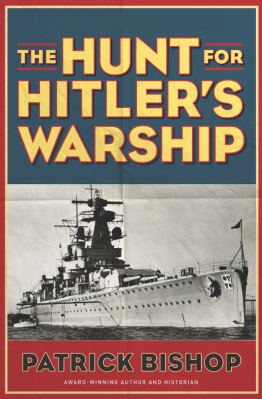The German battleship Tirpitz, as illustrated by the U.S. Navy's intelligence staff during World War II.
Adolf Hitler gets deservedly bad historical reviews, but he makes for great reading. The latest in that category is The Hunt for Hitler’s Warship by British military correspondent and historian Patrick Bishop. His new books tells the tale of Hitler’s mightiest battleship – the one Winston Churchill called “the beast” – and the many allied efforts to send her nearly 50,000 tons to Davy Jones locker.
The book focuses on the men who would not rest until, in one of the Royal Air Force’s most daring operations, under the command of Wing Commander Willie Tait, they had sunk the Tirpitz, named for Grand Admiral Alfred von Tirpitz, the architect of the German imperial navy. Battleland conducted this email chat with Bishop last week.
What made the Tirpitz Hitler’s warship?
Tirpitz was all about might and aggression.
She was bigger and better than anything in the Allied fleet and, with her sister ship Bismarck, was intended to form the core of a mighty German navy that would rule the seas.
Unfortunately the war came to soon for Hitler to realise his ambition. Instead of symbolising Hitler’s triumph it ended up as a monument to his gigantic hubris.
How had the needs of navies changed by the Second World War?
It was already clear by the end of the First World War that the day of the battleship was over.
Von Tirpitz himself – for whom the ship was named – had forseen that the future lay with submarines, and you did not need to be a seer to predict that aircraft were bound to play an increasingly powerful role in future wars at sea.
These truths were demonstrated in the opening clashes of the new conflict with the British fleet suffering badly at the hands of the Luftwaffe in Norway, while the Italian navy proved desperately vulnerable to the aircraft carrier-borne Swordfish of the Fleet Air Arm at the Battle of Taranto in November 1940.
The second war came too hard on the heels of the first for building programmes to take account of the new realities, so all navies were well-stocked with giant but obsolescent craft. In the conflict, submarines and aircraft accounted for far greater tonnages sunk than big surface vessels did.
Tell us a little about the vessel..
She was essentially a conventional battleship, but very heavily armed with eight 15-inch guns and so thickly protected with steel armour plate that she seemed to be unsinkable – once again a metaphor for the pretensions of the Third Reich.
She was big – 47,000 tons (US) unladen, with an overall length of 823 feet.
She was fitted out to the highest standards, and most of the time the 2,000-plus ship’s company lived the life of Reilly. Until the grisly end, hardly any German in uniform can have had a cushier war.
While, not far away on the Eastern Front, their comrades starved and froze, the sailors went skiing and hiking and were entertained with films and concerts by visiting performers. The letters and diaries reflect the guilt that many felt.
It was particularly hard to live with the knowledge that while they were tucked safely in a succession of Norwegian fjords, back home their families were being bombed by the R.A.F.
What was the most surprising thing you learned in researching and writing The Hunt for Hitler’s Warship?
It was probably the realisation that even in the desperate circumstances of wartime, common sense can often be overlooked in favour of other considerations.
Viewed rationally, the threat posed by Tirpitz was limited. Even if she had succeeded in breaking out into the Atlantic, she was not capable of cutting Britain’s lifeline to the Americas. The example of Bismarck, sunk in May 1941, suggested that the likelihood was that she would be intercepted, then hunted down and overwhelmed by the Royal Navy’s superior numbers.
There was, however, much that was irrational about the Allies’ attitude to the German navy’s big ships. They seemed – initially at least – almost to have come to believe that the apparent invincibility of Hitler’s armies must extend to his forces at sea.
By the end the destruction of Tirpitz had become an end in itself, and even though she posed no serious threat to Britain and America’s war aims, great resources were devoted to her destruction. It’s an illustration of how war creates its own dynamic, and it is often easier to continue with a course of action rather than question its actual worth.
You point out that there were 24 major missions to take out the Tirpitz. Were the Germans that good or were the Allies that bad?
There were several factors involved in the repeated failures.
For most of its life, Tirpitz was tucked away in narrow Norwegian fjords – the marine equivalent of slit trenches. Landing a bomb on her was very problematical.
For one thing she was equipped with smoke generators which could cover her in a thick layer of protective fog in minutes. Even when bombs did hit her, as they frequently did, until the very end they were not powerful enough to penetrate her Krupps steel hide.
What was not lacking on the Allied side was courage and ingenuity – exemplified by the midget-submarine attack of autumn 1943, an incredible feat of daring which almost did the job.
Tell us something about the mission that finally succeeded, and James ‘Willie’ Tait.
Tirpitz was finally sent to the bottom as she lay in shallow waters off Tromsø in Northern Norway by the giant bombs of Bomber Command’s 617 and 9 Squadrons on 12 November 1944.
The aerodynamically perfect Tallboy could slice through concrete and steel. Between the first one hitting and the ship turning turtle took only a matter of minutes. It was a grim finish to the story with nearly a thousand seaman dying horrible deaths.
The raid was led by James Tait, who flew over a hundred combat missions.
Despite the fact that he was one of the greatest aerial warriors of World War Two, he is virtually unknown to the general public. Tait was introspective, a music lover who felt uncomfortable in the beery bonhomie of the mess.
He was intensely shy and disdained personal publicity, and were he alive today I’m sure he would have mixed feelings about being featured prominently in the book.




